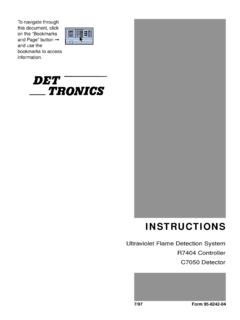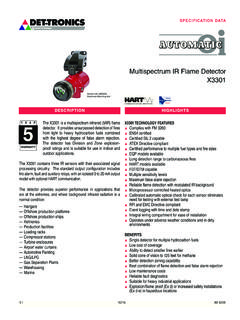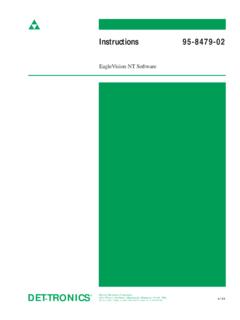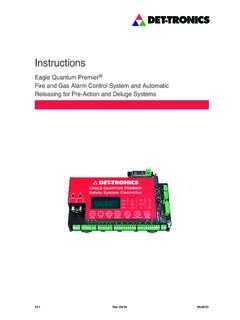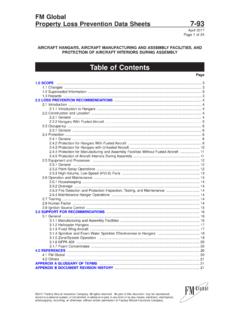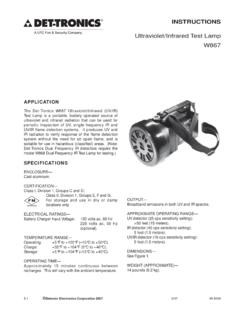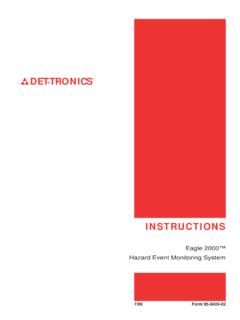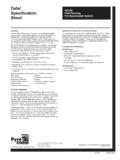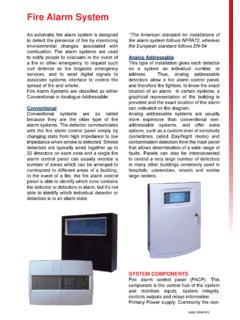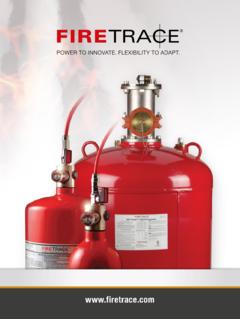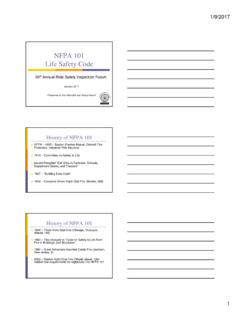Transcription of Compliance Tips: Fire and Gas Detection and Suppression ...
1 WHITE PAPERL iquefied natural gas (LNG) is 600 times denser than the gas form, making the economics to transport LNG more attractive (and more feasible) than transporting natural gas in pipelines over great distances across oceans. There are several proprietary processes used to make LNG, all of which involve refrigerating the gas and then expanding it to turn into a cryogenic liquid. Inherent in these processes are the risks associated with spills and leaks as well as other process as a cryogenic liquid, when LNG warms, it vaporizes (re-gases) and may form a flammable mixture upon reaching a concentration of between 5% and 15% methane-to-air. If LNG should leak to the environment, it will quickly vaporize and form a rising cloud of methane gas, without leaving a residue. The hazard is created when the cloud forms a flammable concentration that presents a risk for ignition.
2 If the leak occurs within a confined area, there is a potential for ignition with explosion. The heat release rate from an LNG pool fire is approximately 60% greater than that of a gasoline pool fire of the same size. There are also non-flammable hazards in LNG facilities due to the presence of refrigerants and other chemicals used in the gas treatment is the job of the facility s fire and gas Detection system to detect these hazards and take appropriate objectivesIn the event of loss of LNG containment, the process facility s fire and gas Detection system must rapidly identify the hazard and indicate its location. Each hazard must be assessed and assigned a Detection scheme with appropriate response actions that are two LNG facilities are exactly the same. Each conforms to its local surroundings, and is laid out and custom-designed to meet specific material, throughput, storage and transport objectives.
3 However, they use common technologies and perform similar performanceThere is a direct correlation between the performance of a fire and gas Detection system and: The appropriateness of the Detection technology selected The number and location of the detectors Environmental conditionsDetermining which types of detectors to use and where to place them requires a review of the process and the hazards presented, as well as fire and gas Detection order for a system to be designed appropriately, system performance must be clearly defined and documented in terms of the hazards present in each process unit (or zone).Detector coverageThe required coverage of hazards by a flame and gas Detection system needs to be specified. This should include specifying the appropriate technology for the Compliance Tips: Fire and Gas Detection and Suppression Systems for LNG FacilitiesPlanning for functional safety requires an understanding of process hazards, relevant industry standards and local codes, and available product and system 800-765-3473detection of the hazard and the required coverage of each hazard.
4 For example, infrared (IR) gas detectors will not detect hydrogen sulfide. The correct mechanical and electrical properties of the detectors must also be carefully selected to ensure that they are appropriate for use in the environment and location in which they are to be models help document a fire and gas system design, and provide calculations for the coverage afforded by a particular Detection scheme to ensure that coverage targets are attained. 3D mapping is also valuable for showing individual detectors obstructed fields of view. (See Figure 1.)Reliable Detection without false alarmsA detector with a greater Detection range is generally considered an advantage, since it means greater ability to detect the hazard either earlier or from greater distances. However, it is important that the detector does not lead to an increased incidence of false system may be configured to automatically initiate corrective actions, including engaging the emergency shutdown (ESD) system , when gas or a flame is detected.
5 However, false alarms that trigger emergency shutdowns are expensive in terms of cleanup costs, lost revenue, and time-consuming reviews, paperwork and reporting. In order to reduce the probability of false alarms and unintended activations, it is imperative to use a performance-certified Detection system that provides immunity to false alarm sources, and is unaffected by electromagnetic interference (EMI) and radio-frequency interference (RFI). This is especially important when a facility uses electrical and fault toleranceRedundancy should be considered based upon the criticality of a component, , the impact of that component s failure. For example, a facility may consist of multiple processing trains, each with its own fire and gas system . In this case, the loss of one controller and therefore one train may not be that critical. However, a single fire and gas controller could be managing an entire facility s fire and gas Detection system .
6 A failure of that controller could lead to facility-wide loss of production; therefore, redundancy of this critical component can increase facility redundancy is employed, the wiring for the redundant components must be carefully analyzed to remove potential common-mode failures that can be caused by using common cable or conduit. Diverse routing of wiring for redundant components will eliminate these possible points of failure. Redundancy in the Detection wiring scheme (Class A) should also be considered for the purpose of reducing the impact of lost alarm addition to the wiring architecture, there are also many environmental factors, such as wind or other sources of air movement, to consider. Environmental factors are even more critical with a voted Detection design. For example, consider two gas detectors installed five meters apart in a zone voted to alarm at 20% LFL/LEL.
7 A larger gas cloud may be needed to contact both detectors to alarm at a 20% LFL/LEL level in a typical outdoor environment. (See Figure 2.) 800-765-3473 White Paper Page 2 Figure 1: 3D mapping can be used to show obstructions in an individual detector s field of 2: Covering a hazard area with voting detectors can reduce the probability of alarming in the face of a legitimate threat, particularly where environmental factors such as wind may be detector types in an LNG processThere are different hazards throughout the LNG process that require different detectors and/or technologies. Figure 3 depicts the detector types suggested at each stage in the liquefaction process. In addition to the need for flame and gas Detection throughout the liquefaction stages, detectors are also needed in other LNG facility hazard zones, such as storage tank process areas, cross-site transfer trenches and emergency impounding basins.
8 (See Figure 4.) The process starts with sour natural gas. As the sour gas passes through the inlet pipes, it enters the inlet scrubber, which removes particulate and liquid contaminants in order to make the gas suitable for further processing. The gas then moves on to the acid gas unit where hydrogen sulfide (H2S) and CO2 are removed. Since H2S is particularly poisonous and flammable, toxic gas detectors are located in this area as well as IR detectors for natural gas (NG). The gas then moves on to the dehydration stage. With the H2S removed, detectors in this area are looking only for NG final liquefaction stage is the refrigeration of the gas. The gas goes through a series of compression and cooling steps that ultimately create the LNG. There are many potential leak points and ignition sources in this area of an LNG facility. Here, point and line-of-sight (open-path) IR gas detectors are configured to identify the spectral signature of the processor s refrigerant gases propane, ethylene or methane.
9 If the hazard is a refrigerant gas composed of a mixture of gases, then a careful review of the mixture should be made in order to determine what the IR gas detectors should be configured to 3: A simplified LNG processDetector TypesMultispectrum infrared flameFixed-point combustible gasFixed-point toxic gasLine-of-sight gasWhite Paper Page 800-765-3473In the final refrigeration step, the chilled gas enters the cold box to be transformed into liquefied natural gas (LNG). From this point forward, IR gas detectors are configured to look specifically for methane leaks. Additional IR gas detectors are placed along the piping as the LNG is transferred to storage tanks, and then finally onto loading racks or jetties for addition to gas Detection , it is also imperative to detect flame hazards throughout the LNG process. The multispectrum infrared (MSIR) flame detector offers optimum performance for this purpose in an LNG and integrationAny effective fire and gas Detection and Suppression system must be capable of interfacing with and integrating flame , gas and smoke detectors, fire Suppression devices and notification fire/gas and Suppression control system must be able to.
10 Reliably detect hazards and provide appropriate audible and visual alarms and location of each hazard Be available during all plant conditions, , plant shutdowns, turnarounds, maintenance Integrate seamlessly to other plant control systems, which provide control of mitigation actions such as starting water pumps, opening deluge valves and closing heating, ventilating and air conditioning inlet dampers Route digital outputs to the emergency shutdown system in order to isolate and shut down process equipmentThe controller must also be able to handle voting logic and support user logic that allows the correct actions to be taken to mitigate the detected Eagle Quantum Premier (EQP) fire- and gas-safety controller by Det-Tronics is one such platform. The EQP provides access to the local operator network (LON) and empowers the operator to configure, program, monitor, diagnose and control the entire system from a single point of designing a fire and gas system in any region of the world, the designer needs to know and understand the applicable code and standards.
